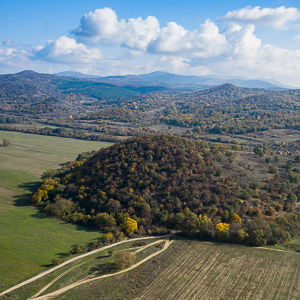
The shape of the pyramid of Stryama, its alignment and the levels, tell us how it was specifically built to reflect a plan. The soft molten shape of the stones with the skewer holes reveals the technique used to make the megaliths and the overall pyramid. The quartz that is found in the granite mix and layered in linear blocks as well as the gridlines that underpin the edifice tell us about the purpose of the pyramid.
The Middle Mountain band of megalithic sites
The pyramid of Stryama is part of the Middle Mountain band of megalithic sites.
The neighbouring sites
Stryama is surrounded by many megalithic sites, many of which have not yet been visited and added to the inventory. Some are already inventorised:
- Bania
- Sokolitsa
- Ivan Vazovo
- Pesnopoy
- Begovo
- Hisaria
- Rozovets
Patterns between the sites
The pyramid of Stryama is a node in the network of megalithic sites in the Middle Mountain region. It binds together other pyramidal formations to create patterns that reflect the layout of the stars above.
When we connect Stryama with other megalithic sites nearby we find alignments that remind us of Orion’s belt and the Giza pyramids.
The pyramid of Stryama has a circular base which is 450m in diameter.
The pyramid of Stryama is only 44m high from base to summit.
Inclination
The gradient on the North side is steeper 24%. The South side has a more gentle slope of around 10%.
Alignment
The lines of stone on the South side of the pyramid are not perfectly aligned due South. They are aligned South-South East and are off exact cardinal alignments by around 15-20 degrees.
Levels
The pyramid has 5 distinctive levels on the South side. There is a single summit.

The stones of the Pyramid of Stryama tells us about different epochs of megalith building and reveal the techniques used to make the stones.
The shape of the stones
The stones we notice that they are molded like putty. It feels that they were melted into shape.
Periods of construction
There are at least 2 periods of megalithic building at the pyramid of Stryama. The base stones that are bigger and lumpier can be associated with the Lemurian epoch. They are akin to the stones of the Hanan Pacha period in Peru which is the earliest period of megalithic building at Machu Picchu.
There are also relatively smaller standing stones that have been toppled that would be associated with the early Atlantean epoch and are akin to the Urun Pacha period in Peru.
Skewer holes
At Stryama we found skewer holes in the granite stone that are located at the base of the pyramid. The stones are from the earliest epoch of construction. And there are several skewer holes.
The stone looks like granite that was once soft and malleable. It seems to have been molded on a skewer around the drill hole just like you would melt a marshmallow on a stick.
Sutures
There are suture marks in the stone that remind us how glass is pressed into shape.
Type of stone
The stone most commonly found at Stryama is a granite cement mix with pieces of quartz.
Lines of quartz blocks in the granite
Some stones are inlaid with quartz blocks like a sandwich. One specific stone has a diagonal quartz line similar to those found nearby in Bania and Sokolitsa. But has been toppled and is lying down sideways.
Grid lines of quartz underground
In Stryama there are the lines of quartz in the ground aligned at right angles. This cross formation is located at the base of the pyramid which can mean that there is an underlying structure of quartz lines like a grid beneath the pyramid that can conduct energy.
Transcript of the video documentary on the Pyramid of Stryama
Talking to Stones in Stryama Bulgaria
Visiting a new pyramid is like listening to a radio station. You never know what to expect.
Stryama is one of the smaller pyramids. And yet the stones are full of surprises. There are many interesting features that help us answer the key question as to why the pyramids were built.
We can discover why the Stryama pyramid was built by listening to its position and location as well as the shape and composition of its stones.
Position
The pyramid of Stryama has a circular base which is 450m in diameter.
It is only 44m high from base to summit. It stands at 260m elevation which is similar to the pyramids of Plovdiv.
The gradient on the North side is steeper 24%. The South side has a more gentle slope of around 10%.
On the South side which is not covered by foliage you can see at least 5 levels + the summit.
Location
The Stryama pyramid is not the loudest voice in the chorus. And yet it’s contribution seems crucial. By its location it plays a central role in bringing together the cacophony of all the other regional sites.
You can see from the density of yellow dots on the map that the entire region of the Middle Mountain is megalithic! This is not even a complete list. There are many more sites to discover.
The Stryama pyramid is a great example of how megalithic sites are connected in a grid. It is not built independently as a one-off. Its role can be deciphered from the connection between the network of sites.
The Middle Mountain includes sites like
- Rozovets which is precisely due East at 90 degrees and 20km away
- Pesnopoy is 1.5km away exactly at 135 degrees to the North West
- The Double Pyramid of Bania 8km
- Hisaria 9km
And there are more megalithic sites in the vicinity. Understanding the pattern between these sites will help us understand their function and answer the question as to why they were built. We will finally hear the melody and understand the message. The distance, direction and elevation are the main characteristics we have to take into account to put together this giant multidimensional puzzle. And just like music the melody can be deciphered with numbers.
There is a straight diagonal line North West to South East at 135 degrees that joins the double summits of Pesnopoy and that of Stryama. There is bound to be a connection here. Such big structures would not be built with such specific cardinal alignments without a reason.
The blue line that passes between Pesnopoy and the 2 other megalithic sites is proportionally similar to the alignment of the Giza pyramids and Orion’s belt. The distances are proportionally the same and so too is the alignment of the 3 points. There are many dots to be linked and patterns to be recognised for us to decipher the message and hear the music.
The pink line connecting Stryama and 2 other local pyramidal formations reminds us again of Orion’s belt and the angle to Orion’s nebula. Maybe you too can find new connections? All this data is freely available as part of the Bulgaria Pyramid Project.
What we can already hear now is that Stryama is a node in the network of megalithic sites in the Middle Mountain region. It binds together the other pyramid formations.
The real question is: Exactly what are the stars and planetary bodies in the sky that are represented in these monumental structures on Earth ? And what does this mirror image of the cosmic order tell us about the layout of the heavens above?
Shape
When we listen carefully to the stones we notice that they are molded like putty. It feels that they were melted into shape. It is similar to what has been called in Peru the Hanan Pacha period which is the earliest period of megalithic building at Machu Picchu.
In Stryama the oldest style of stone is found at the bottom of the pyramid. Most fascinating is the discovery of drill holes. They are identical to those found at the Double Pyramid of Bania.
The stone seems to have been molded on a skewer around the drill hole just like you would melt a marshmallow on a stick.
And there are suture marks in the stone that remind us how glass is pressed into shape. We found similar ones at other sites like Rozovets and Bania.
This is a completely different building technique from the rectangular chiseled blocks found at the Giza pyramids.
It is similar to the type of technique and stone found at Rozovets.
This technique is a reflection of an earlier form of consciousness.
Just like the Stone Age and Iron Age represented different stages of human evolution, this molten technique represents an epoch and a different form of consciousness. Humanity had a different relationship to the earthly and cosmic realms.
At this time humans did not have the self awareness to chip, chisel and break nature to fit it to its square understanding of the universe. They did not have the individuality we attribute to ourselves today.
This was an epoch when humans were just an extension of the cosmic order. I will discuss this in more detail in the video on the dating of these megalithic sites.
Composition
As we listen closely to how the stones are made we notice that the stone most commonly found at Stryama seems to be a granite cement mix with pieces of quartz.
Some stones are inlaid with quartz blocks like a sandwich. It is very similar to other local sites like Sokolitsa, Bania and Rozovets.
There is a stone with a diagonal quartz line similar to those standing at Bania and Sokolitsa but in this case it is lying down sideways. The diagonal line reminds us of the precessional tilt of the Earth as well as the angle of the Orion nebula in relation to Orion’s belt. The Orion nebula is where stars are born.
Even more interesting are the lines of quartz in the ground aligned at right angles. This cross formation is located at the base of the pyramid which can mean that there is an underlying structure of quartz lines like a grid beneath the pyramid that can conduct energy.
At the summit we found that grave robbers had tried to borough their way through the top of the pyramid. Maybe it had been used at a later date for Thracian burials which is common in Bulgaria. The stone and soil that had been removed was a mix of quartz cement mix, quartz pieces and interestingly white stone similar to river stone found North of the Central Balkan as well as a piece of some kind of flat and polished pottery or human made artifact.
Conclusion
The stones of Stryama tell us about their purpose.
The drill holes tell us that the stones of Stryama were produced with a specific intention.
The quartz that we find in both the cement mix and inlaid as blocks points to the fact that the pyramid had an energetic function. We found the same conclusion in Rozovets. It was most probably used to transfer energy between Earth and the cosmos.
The pyramid of Stryama tells us how megalithic sites are part of a network like the pieces of an engine. Even the smaller pieces are necessary for the engine to function. The Bulgaria Pyramid Project is like reverse-engineering a jet engine when we have never seen a plane fly. We have to imagine what might have been.
The alignment of the Stryama pyramid with other local sites that together form patterns similar to those of constellations such as the Orion reveals to us how mirroring the cosmic order attracts and reproduces the energy of the universe on Earth. Stryama is just one part of a mirror that acts as a portal to transfer energy between the cosmos and Earth.
In Rozovets the stones tell us a similar story. And I invite you to watch the video for a more in depth analysis.







